39. Dorset: Around Cerne Abbas (figure of eight) - 8 miles - OS Explorer 117
- Admin
- Oct 26, 2022
- 5 min read
Updated: Sep 26, 2023
Easy going. Well, it needs to be after the shock of seeing one of Dorset's larger flashers. Bronze age?

Settled in chalk downs, Cerne Abbas has more than a club welding nudist with a twenty-six-foot penis to draw the visitor. It gets lots of those in summer, so, do it in Autumn if you can. The surrounding countryside and village glows in the low sun, and the streets and paths are quiet. Not a sign of the fertility hungry hedonists that sometimes cavort here for spiritual (ho-ho) reasons.

Park up at the Giant’s Viewpoint by the A352, on the outskirts of the village. Other than by helicopter, it is the best view of the Giant. I did this walk in October 2022. A glorious day but the giant looked neglected,. The usually bright white outline of trench-dug chalk was grey and in need of a trim. A legacy of Covid cuts or bad timing, I don’t know, but it’s about time they re-membered (pun intended) his tourist value and gave him a spruce up.
It looks ancient, and there are bronze-age earthworks nearby, but many believe it's a 17th century; a satirical dig (hey, another pun) by Royalists at puritanical Oliver Cromwell.
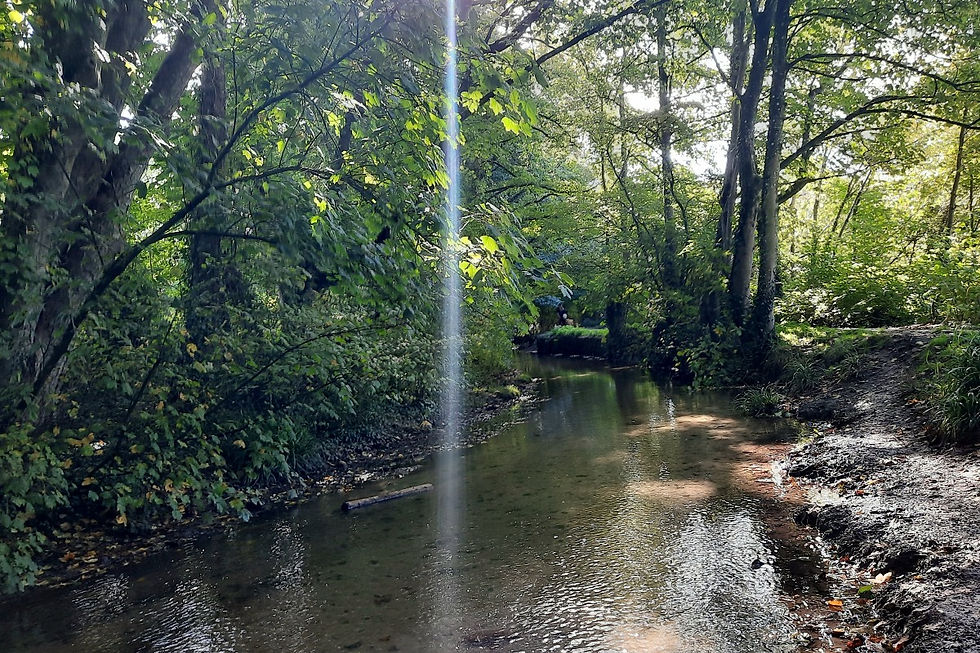
To stop you wondering why Royalists would give their enemy such an impressive organ, it’s rumoured it was once much smaller; the length increased by wags who extended the vertical lines to what was once his belly button. A case of truth not being stranger than fiction.
There’s a lane leading to the village from the viewing point (signposted). Boots tied, follow this then first left to Kettle Bridge (signposted). Don’t cross it. Take the path on the right immediately before it to follow the river Cerne into town.

There are fine buildings in the centre that speak of wealth. That came from Cerne Abbey, first founded in the 9th century. Land is power and the Catholic church’s monasteries and abbeys, profiting on beliefs that their blessings (available at a price regardless of merit) offered a get-free-to-heaven-pass-despite-your-sins, inherited huge amounts of land and wealth from the elderly rich. Henry VIII and his impatient libido and empty coffers put an end to that in the 16th century. The abbey is now mostly a ruin, viewed by taking a stroll down Abbey St.
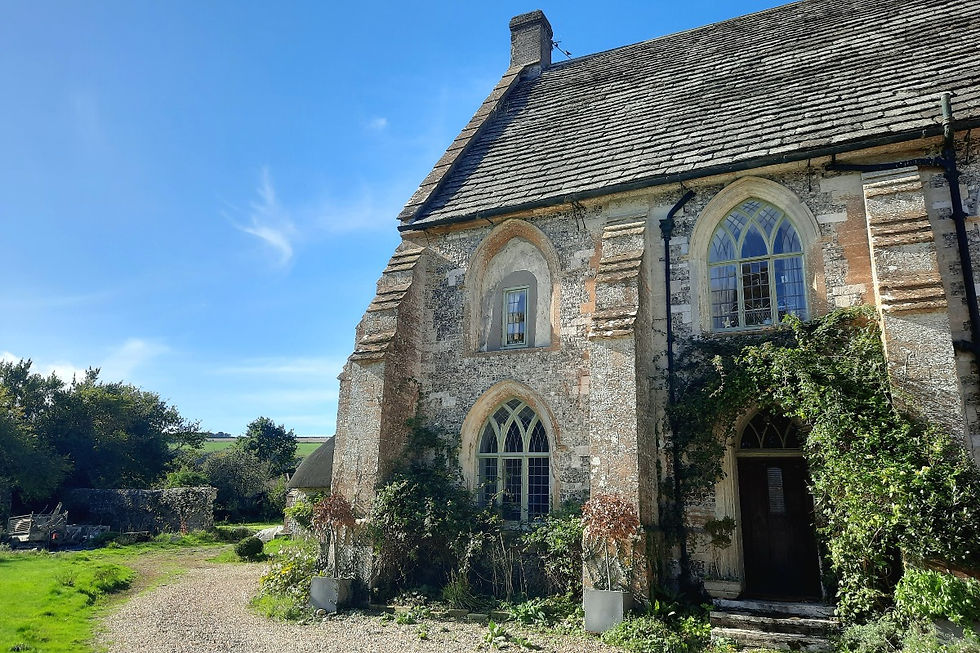
Enough of Abbey Street, return to the main thoroughfare of Long St. and turn right, passing The Giant Inn and New Inn before coming to a red phone box. Turn left here, then soon right off the lane onto a footpath by a large but nameless house (numbered 2). At the end of this don’t re-join the road but turn left by a footpath sign. It takes you through a gate to Tythe Barn (a 14th century storage facility for the abbey) but don’t walk up the driveway. Keep to the narrow path on the left. You’ll still get a good view of the impressive but not very barn-like barn.
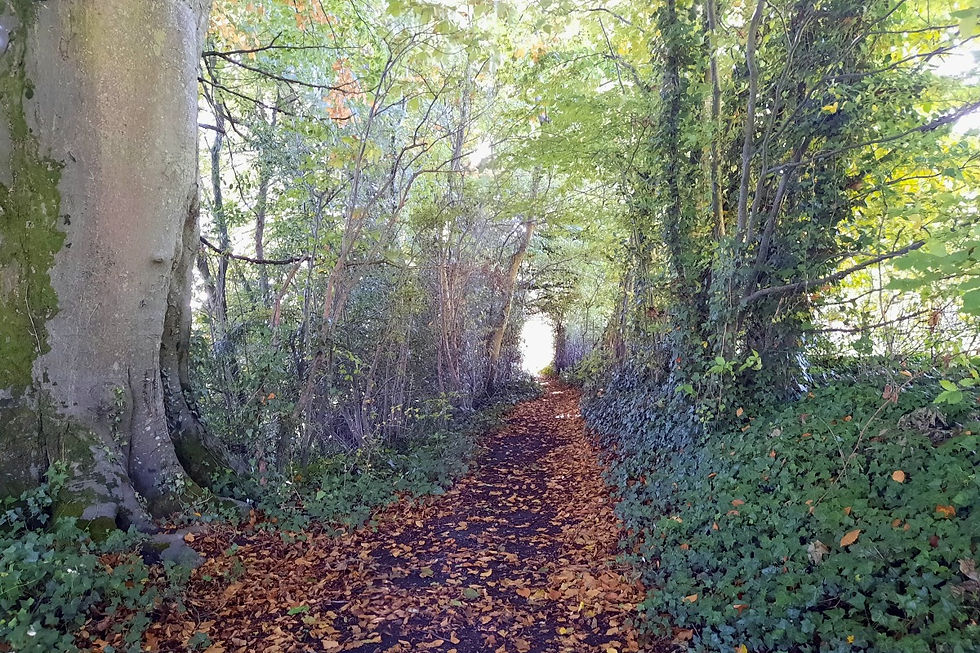
Over a couple of stiles, through a gate onto Barton Farmland, follow the footpath right (yellow waymarker). More stiles then into a field and onto a wooded track ending at a lane. Turn left here toward Cerne Abbas brewery (well signposted).
It's a tempting brewery to explore, and the beauty of the relatively short walks on this blog mean you always have time to.
With the brewery on your left, carry straight on through a farm gate. More lovely woodland.
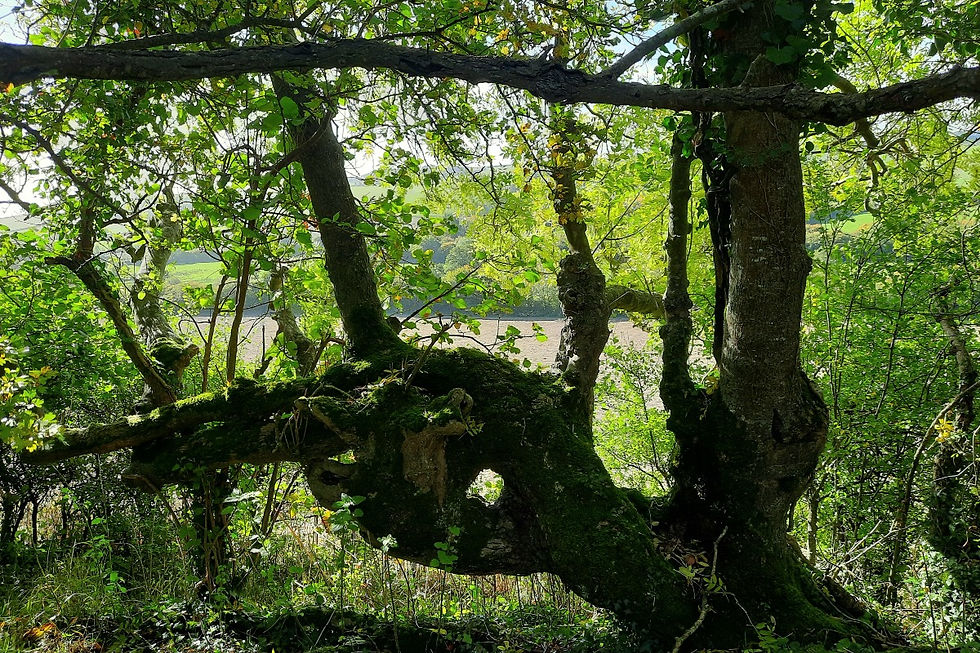
Where the path ends at another, turn right toward Lower Pound Farm. After a third of a mile, keep your eyes out for a path on your right, down to a couple of stiles. It's just before the main path enters a field. This new path will bring you to the farm.
On entering the farmyard, turn left up a track toward Bramble Bottom, named after a rash the Cerne Abbas Giant… (nah, only kidding). Turn left off this farm track after a fifth of a mile at a yellow waymarker.
Somewhere along here, I missed a path in the hedge to my right and ended up following the hedge on the wrong side. No matter, a thoughtful walker or farmer had placed an old branch over barbed wire in the far corner, allowing me to re-join the path through the lovely valley of Bramble Bottom.
It ends at crisscrossing tracks with Upper Pound Farm ahead. Go left. Immediately this track divides. Go right, and shortly after, right again over a stile into a field.
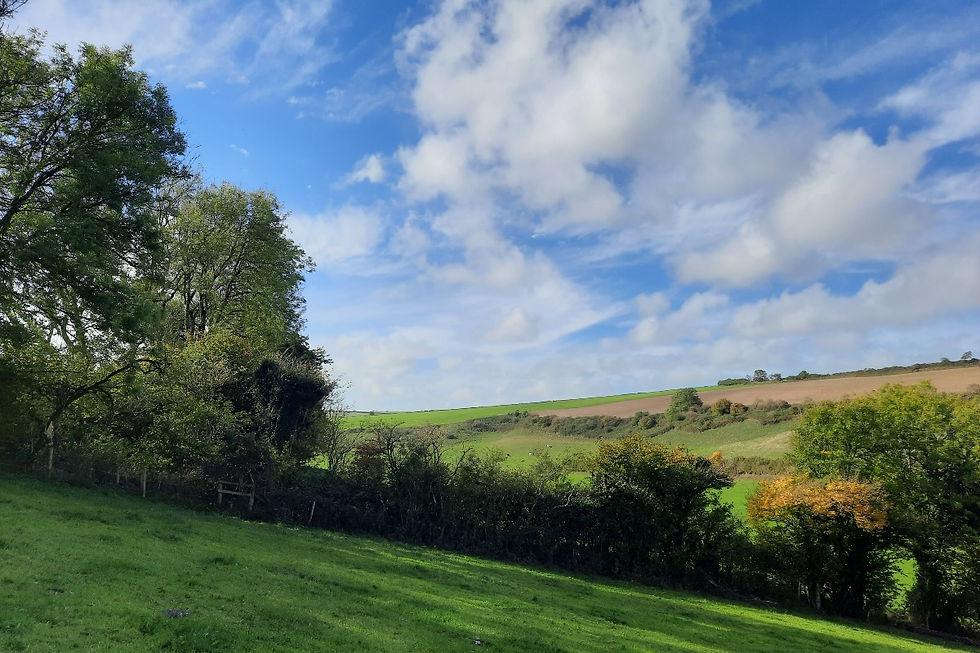
Ahead is Black Hill Farm. Follow the path (or skirt the field if there’s a crop) to the lane by the farm, turning left onto the lane. With Black Hill Farm on your left keep ahead to a path right of a double garage.
Seeing a large green shed ahead, look for a yellow footpath sign and stile on the right. Rare breed pigs were this little enclosure. One a little lively and I wondered if I might get chased out. Fortunately, his bravado left him when he no-longer had the fence between us.
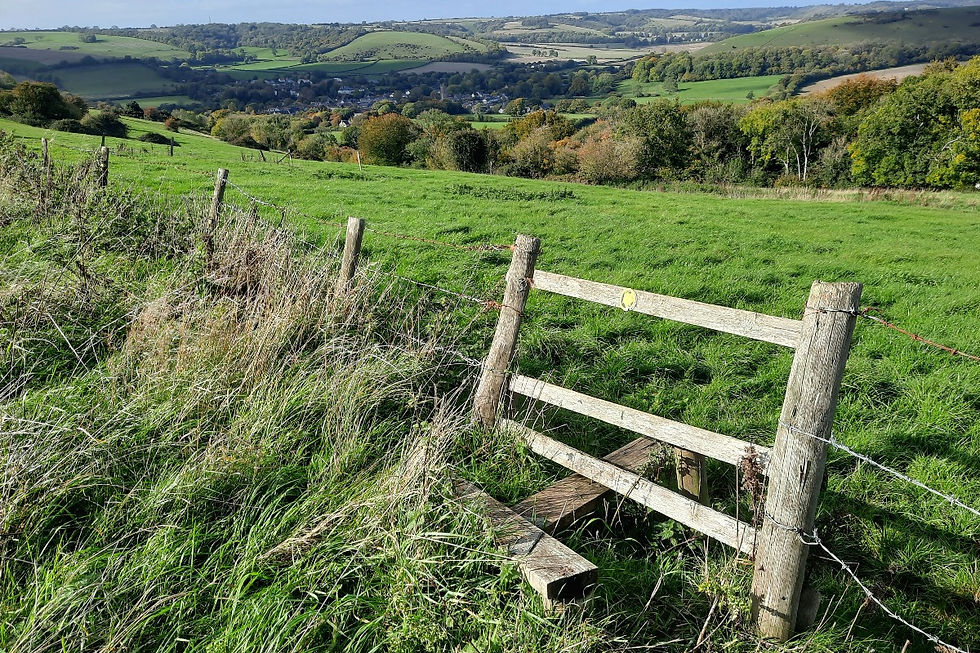
Over a second stile into a large field at the other side, turn left (west) and head to the hedge ahead before turning north (right). After about a sixth of a mile following this hedge, there's yet another stile, on your left. Following the point of the footpath sign, head diagonally down, crossing other stiles to a lane leading back to Cerne Abbas.
No need to follow the lane down very far. Look out for a farmers gate on your left. To its right is a pretty path down to the village.

Making you way back to the centre through some new housing, I’d suggest an ale. You've earned it. I chose the New Inn, but The Giant and the ivy clad Royal Oak looked good picks too.
Why so many pubs? In its heyday, while the Abbey and trade flourished, it needed them.
Refreshed, turn east up the main street, passing the Royal Oak on your left. Reaching Simsay Fields (a close of modern houses on your left), cross and take the path ahead that leads into a field.
Entering the field with the village cricket ground straight ahead, take the diagonal path left to the far hedge and through a gate. Turn left here to follow the eastern rim of Giants Hill.
Follow the path for just over half a mile, until you see a yellow waymarker by a wide gate into a filed on your left. About two-thirds of the way across the field, take a path heading south (left) to a stile. Crossing over, take the path following the west rim of Giant Hill.

Look carefully as you approach the fenced in Cerne Abbas Giant and you’ll glimpse the chalk trenches that delineate him. What you won’t see is the giant. This close up, he’s invisible. As I suppose we are to a flea. An observation that could answer the 'where's God?' question, if I were to stray into earnest theology, so I'll stop there.
All sorts of naught fertility rites, formal and informal, have taken place here, or, more precisely, on his most impressive feature (maybe that's why they enlarged it - to make more room to - what's the word? - frolic?).
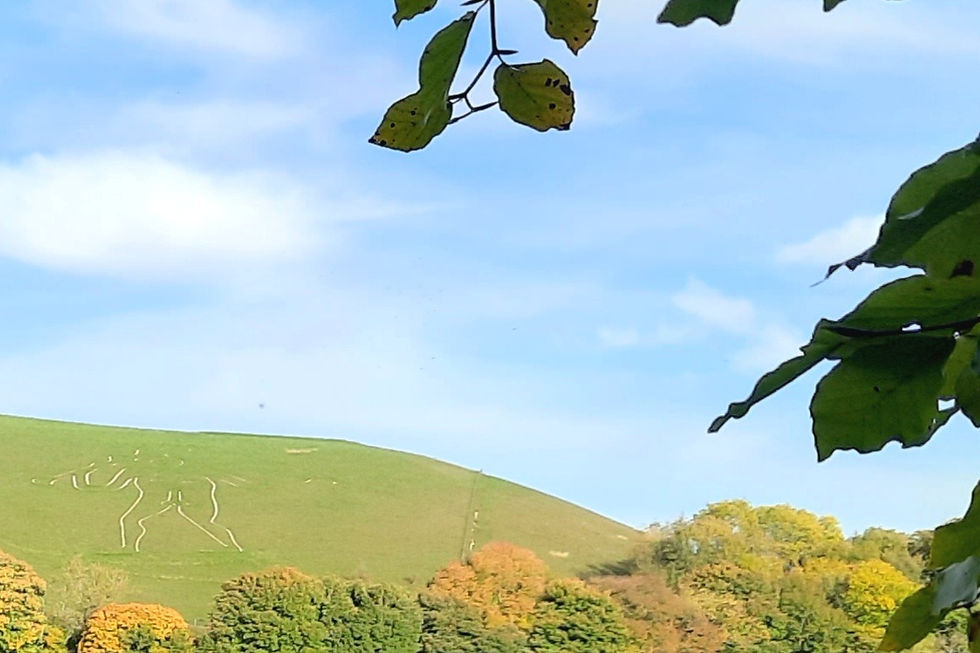
Passing the invisible giant, the path drops into a pretty wood and divides. Follow the sign to Kettle Bridge and cross it to return to your car and what is likely to be a better view of the giant with the low sun behind you.
Ps.. As with many of the walks on this blog, the drive through country lanes to this curious place is as delightful as the walk.
Enjoy!




















Comments